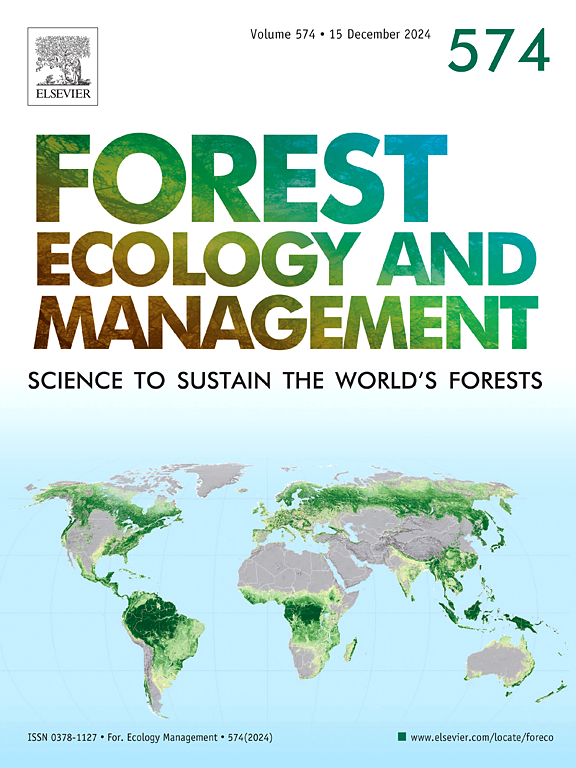评估燃料处理对美国西部干针叶林燃料负荷的短期影响:一项荟萃分析
IF 3.7
2区 农林科学
Q1 FORESTRY
引用次数: 0
摘要
燃料处理对于减少野火危害至关重要,特别是在美国西部干燥针叶林严重野火增加的情况下。虽然许多研究证明了燃料处理在降低未来野火严重程度方面的有效性,但很少有综合数据来预测主要燃料类别的处理后燃料负荷。我们对美国西部干针叶林发表的65篇论文进行了1932年的贝叶斯荟萃分析,以(1)评估不同燃料处理对燃料负荷和林下结构的短期影响,(2)表征多种燃料成分处理后燃料负荷和林下结构的模式。治疗方法包括稀释后进行规定的灼烧(THIN+BURN)、仅稀释(THIN)和首次入组仅规定的灼烧(BURN)。研究结果表明,不同的处理方式有效地降低了林分燃料负荷,但效果因处理方式、林分类型和初始林分条件而异。THIN+BURN处理在减少层上燃料负荷和防止表面燃料堆积方面最有效,而BURN处理在减少表面燃料负荷方面最有效,即使在单次进入后也是如此。我们的研究结果强调了处理类型和预处理条件在影响燃料减少结果中的重要性。燃料处理,特别是在燃料负荷较大的景观中,为缓和野火严重程度、降低火灾风险和促进森林恢复提供了有价值的工具。我们对处理后燃料负荷的综合研究为评估森林脆弱性、改进火灾行为模型估计以及为气候变化中的野火管理策略提供了重要见解。本文章由计算机程序翻译,如有差异,请以英文原文为准。
Evaluating short-term effects of fuel treatments on fuel loading in western US dry conifer forests: A meta-analysis
Fuel treatments are crucial for reducing wildfire hazard, especially as severe wildfires increase across western United States (US) dry conifer forests. While many studies have documented the effectiveness of fuel treatments in reducing future wildfire severity, few have synthesized data to predict post-treatment fuel loads for major classes of fuels. We conducted a Bayesian meta-analysis using 1932 observations from 65 published papers in western US dry conifer forests to (1) evaluate the short-term effects of different fuel treatments on fuel loading and overstory structure and (2) characterize patterns of post-treatment fuel loading and overstory structure across multiple fuel components. Treatments included thinning followed by prescribed burning (THIN+BURN), thinning only (THIN), and first-entry prescribed fire only (BURN). Our results show that treatments effectively reduce fuel loads, but outcomes vary based on treatment type, forest type, and initial stand conditions. THIN+BURN treatments were most effective in reducing overstory fuel loads while preventing surface fuel buildup, whereas BURN treatments were the most effective at reducing surface fuel loads, even after a single entry. Our findings underscore the importance of treatment type and pre-treatment stand conditions in influencing fuel reduction outcomes. Fuel treatments, especially in landscapes with heavy fuel loads, offer a valuable tool for moderating wildfire severity, reducing fire risk, and promoting forest restoration. Our synthesis of post-treatment fuel loads provides important insights for assessing forest vulnerability, improving fire behavior model estimates, and informing wildfire management strategies in a changing climate.
求助全文
通过发布文献求助,成功后即可免费获取论文全文。
去求助
来源期刊

Forest Ecology and Management
农林科学-林学
CiteScore
7.50
自引率
10.80%
发文量
665
审稿时长
39 days
期刊介绍:
Forest Ecology and Management publishes scientific articles linking forest ecology with forest management, focusing on the application of biological, ecological and social knowledge to the management and conservation of plantations and natural forests. The scope of the journal includes all forest ecosystems of the world.
A peer-review process ensures the quality and international interest of the manuscripts accepted for publication. The journal encourages communication between scientists in disparate fields who share a common interest in ecology and forest management, bridging the gap between research workers and forest managers.
We encourage submission of papers that will have the strongest interest and value to the Journal''s international readership. Some key features of papers with strong interest include:
1. Clear connections between the ecology and management of forests;
2. Novel ideas or approaches to important challenges in forest ecology and management;
3. Studies that address a population of interest beyond the scale of single research sites, Three key points in the design of forest experiments, Forest Ecology and Management 255 (2008) 2022-2023);
4. Review Articles on timely, important topics. Authors are welcome to contact one of the editors to discuss the suitability of a potential review manuscript.
The Journal encourages proposals for special issues examining important areas of forest ecology and management. Potential guest editors should contact any of the Editors to begin discussions about topics, potential papers, and other details.
 求助内容:
求助内容: 应助结果提醒方式:
应助结果提醒方式:


